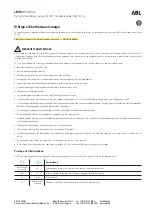
46
Use only the recommended oils.
It is forbidden
to mix motor oils of various brands and manufacturers!
When pouring engine oil of another brand or
company, flushing the lubrication system with flushing oil is obligatory. Select the flushing oil in accordance with the
recommendations of the manufacturer of the new oil to be poured.
When changing the oil, change the oil filter. Used oil shall be drained from the crankcase immediately after the ride
while it is hot. In this case, the oil is drained quickly and completely.
Oil filter 13 (Fig. 9.3): in order to remove, it is necessary to turn counterclockwise. When installing a new filter,
make sure that the rubber sealing ring is in good condition and lubricate it with engine oil, screw the filter until the sealing
ring touches the plane on the cylinder block, and then tighten a further 3/4 of a turn. Check for oil leaks.
Fig. 9.3 Engine (right view):
1 - coolant outlet pipe to the heater; 2 - coolant inlet pipe from the heater; 3 - detonation sensor; 4 - fuel pipe connector; 5 - fuel rail with
jet nozzles; 6 - absolute pressure sensor;7 - upper hydraulic tensioner cover; 8 - front engine lift; 9 - oil outlet to the oil radiator; 10 -
thermal valve; 11 - cover of the lower hydraulic tensioner; 12 - crankshaft position sensor (timing sensor); 13 - oil filter; 14 - cover of
the oil pump; 15 -starter; 16 - the position pin of the gearbox
In case of the intact lubrication system, with the warm engine running in idle mode, the warning lamp of the
emergency oil pressure can glow, but shall immediately go out as the crankshaft speed increases.
Upon two oil changes, it is recommended to flush the engine lubrication system, for which purpose the used oil shall
be drained, a special cleaning oil, filled in 3-
5 mm above the “MIN” mark of the oil level indicator, and the engine shall be
allowed to run for 10 minutes. Then the cleaning oil shall be drained, replace the oil filter replaced and the fresh oi refilled.
In the absence of wash oil, flushing can be done with clean engine oil.
Engine Crankcase Ventilation System
When servicing the ventilation system, remove the valve cover (Fig.9.4), main and small ventilation hoses and clean
the removed parts. Clean the holes for drainage of the separated oil in the gear lubricant deflector, holes in the valve cover
vent pipes, receiver and throttle body. Flush the oil deflector without removing it from the valve cover. When assembling,
provide the tightness of the connections.
CAUTION! Do not operate the engine with a non-tight ventilation system and an open oil filler pipe. This will
cause an increased oil carryover with crankcase gases and environmental pollution. To prevent depressurization of the
vent system, the oil level gauge must be set as far as it will go.
CLEAN
AIR
MIXTURE OF CRANKCASE
GASES AND CLEAN AIR
















































